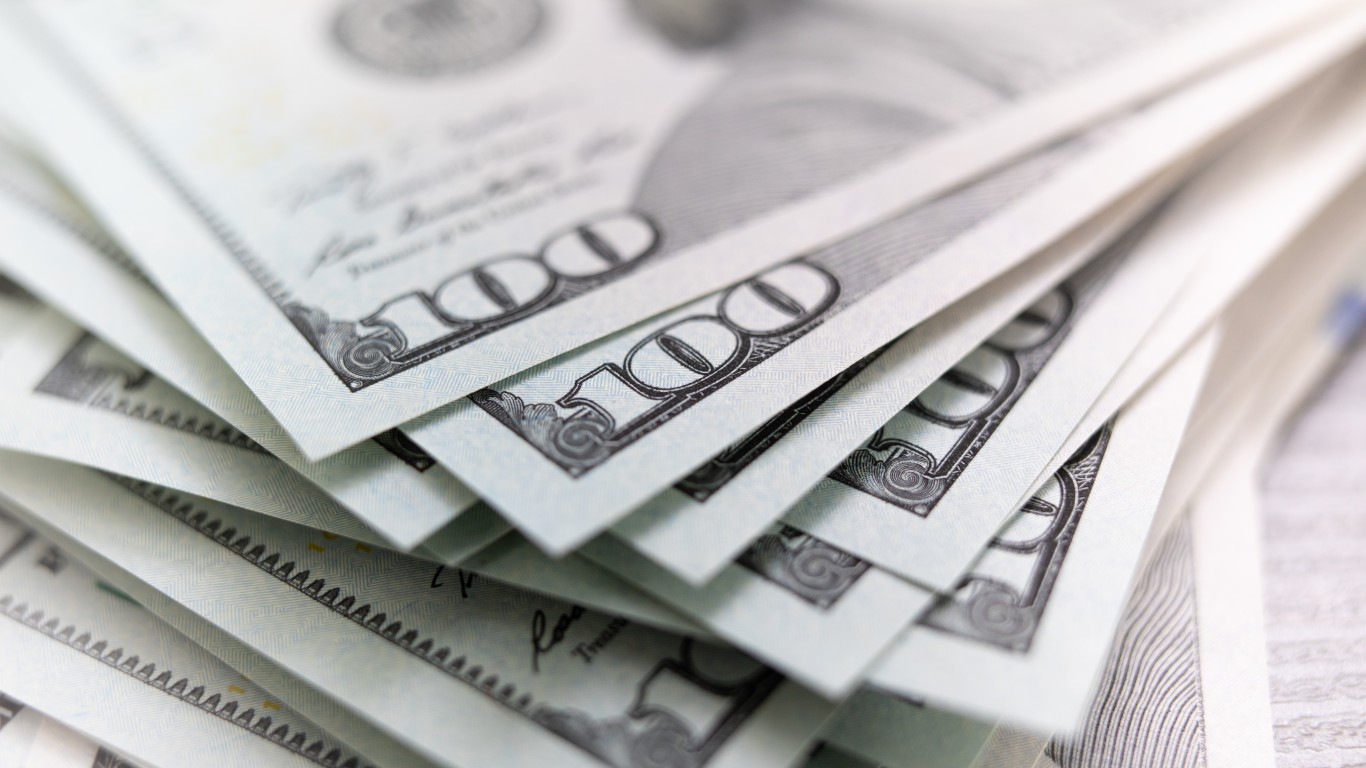
The Standard & Poor’s 500 Index was created by credit agency Standard & Poor’s in 1957. While the index is not specifically the top 500 U.S. companies per se, it does represent a good average representation of US economic corporate strength. Its range and depth is relatively proportionate to US industrial sector leadership positions, and thus a fairly accurate gauge of US economic market health.
24/7 Wall Street Insights
- The S&P 500 represents among 500 of the largest market cap U.S. companies that trade publicly.
- Over 80% of the S&P 500 stocks pay dividends.
- Dividend stocks are an excellent passive income vehicle due to the flexibility of parameters in their availability for portfolio customization.
The index is market cap weighted and rebalances every quarter, so stocks that falter may be dropped so that better performing ones can be included. The stocks’ weighting is not fixed, which is why “The Magnificent Seven” tech stocks influence the S&P 500 index disproportionately of late.
While the index itself is not a tradable security, there are a number of exchange traded funds (ETF)s that mirror the S&P 500 that are sponsored by BlackRock, Vanguard, and other institutions.
Dividends

Although not all S&P 500 member stocks pay dividends, over 400, or 80% of them, do pay dividends, albeit some more than others. The bulk of the dividend paying stocks pay between 1% and 2%. Only about 40 of them pay over 4%. Those stocks that have consistently raised their dividend for 4 or more years are categorized as “aristocrats.”
A number of analysts use different offshoots of the S&P 500 dividend yield and have created ETFs that track the average S&P 500 dividend yield, the dividend aristocrats’ average yield , and various other configurations.
The List of 15

The following 15 stocks are among the highest yielding S&P 500 member stocks. Given the recurring monthly income design of the real estate industry, the preponderance of real estate based stocks may seem to be over weighted. However, high, double-digit dividend yield income is a sector that is dominated, for the most part, by real estate (REIT), business development companies (private debt and equity), and shipping. The ones that are sizable enough to make it for inclusion in the S&P 500 may not have the highest dividends for their respective sectors, but certainly maintain their sector’s dividend strength relative to others, like utilities, healthcare, transportation, and others. Yields are based on market price at the time of this writing.
1) Walgreens Boots Alliance (NASDAQ: WBA) – 11.08% (healthcare retail products)
2) Altria Group, Inc. (NYSE: MO) – 8.21% (tobacco)
3) Verizon Communications, Inc. (NYSE: VZ) – 6.31% (telecommunications)
4) Franklin Resources Inc. (NYSE: BEN) – 6.14% (financial)
5) Pfizer Inc. (NYSE: PFE) – 5.73% (pharmaceuticals)
6) Crown Castle Inc. (NYSE: CCI) – 5.69% (REIT)
7) LyondellBasell Industries, NV (NYSE: LYB) – 5.66% (chemicals)
8) Ford Motor Company (NYSE: F) – 5.62% (transportation)
9) Healthpeak Properties (NYSE: DOC) – 5.58% (REIT)
10) AT&T (NYSE: T) – 5.23% (telecommunications?
11) Dow Inc. (NYSE: DOW) – 5.22% (plastics)
12) Realty Income Inc. (NYSE: O) – 5.14% (REIT)
13) Truist (NYSE: TFC) – 4.90% (financial)
14) Simon Property Group (NYSE: SPG) – 4.89% (REIT)
15) Keycorp (NYSE: KEY) – 4.87% (financial)
Passive Income Needs

The recent Consumer Price Index results on inflation showed some stark price escalations comparisons between the last 4 years (from 2020) and the 4 years prior (2016-2020). Among the highest inflation differentials were:
- School Food at K-12 Schools: -9.3% (2020) vs. +69.7 (2024)
- Hotels: -15.1% (2020) vs. +42.4% (2024)
- Car Insurance: 6.7% (2020) vs. +56.5% (2024)
- Fuel Oil: -5.1 (2020) vs. +37.4% (2024)
With such examples of price squeezing, many people with investable liquidity will look to create passive income to cover their additional day-to-day costs. The high costs of investing in direct real estate or an ongoing successful business may be prohibitive for many. Dividend stocks may offer the solution.
Why Dividend Stocks?

As a source of passive income, dividend stocks have a number of attractive features:
- Low cost of admission (unlike investments in real estate or other businesses)
- Diversification of Industry (managing risk with a portfolio mix of various sector stocks)
- Liquidity (T+1 is now standard)
- Volatility ranges (beta ranges to suit the spectrum of risk tolerances)
- Replaceability (if one stock receives adverse news, it can easily be replaced by another stock with a comparable yield)
24/7 Wall Street has an enormous database of dividend stocks to suit all levels of risk tolerance, and has published numerous past articles highlighting them.
Travel Cards Are Getting Too Good To Ignore (sponsored)
Credit card companies are pulling out all the stops, with the issuers are offering insane travel rewards and perks.
We’re talking huge sign-up bonuses, points on every purchase, and benefits like lounge access, travel credits, and free hotel nights. For travelers, these rewards can add up to thousands of dollars in flights, upgrades, and luxury experiences every year.
It’s like getting paid to travel — and it’s available to qualified borrowers who know where to look.
We’ve rounded up some of the best travel credit cards on the market. Click here to see the list. Don’t miss these offers — they won’t be this good forever.
Thank you for reading! Have some feedback for us?
Contact the 24/7 Wall St. editorial team.





